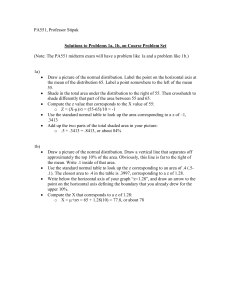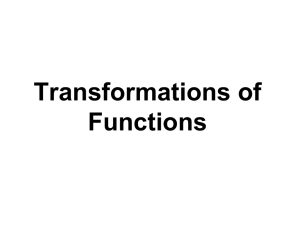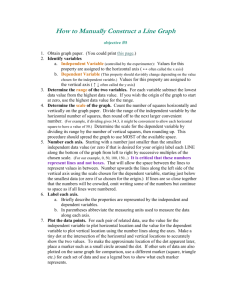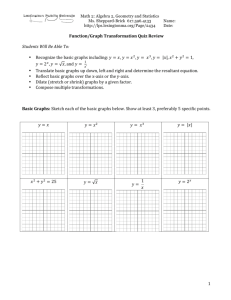Chapter2 solution2
advertisement
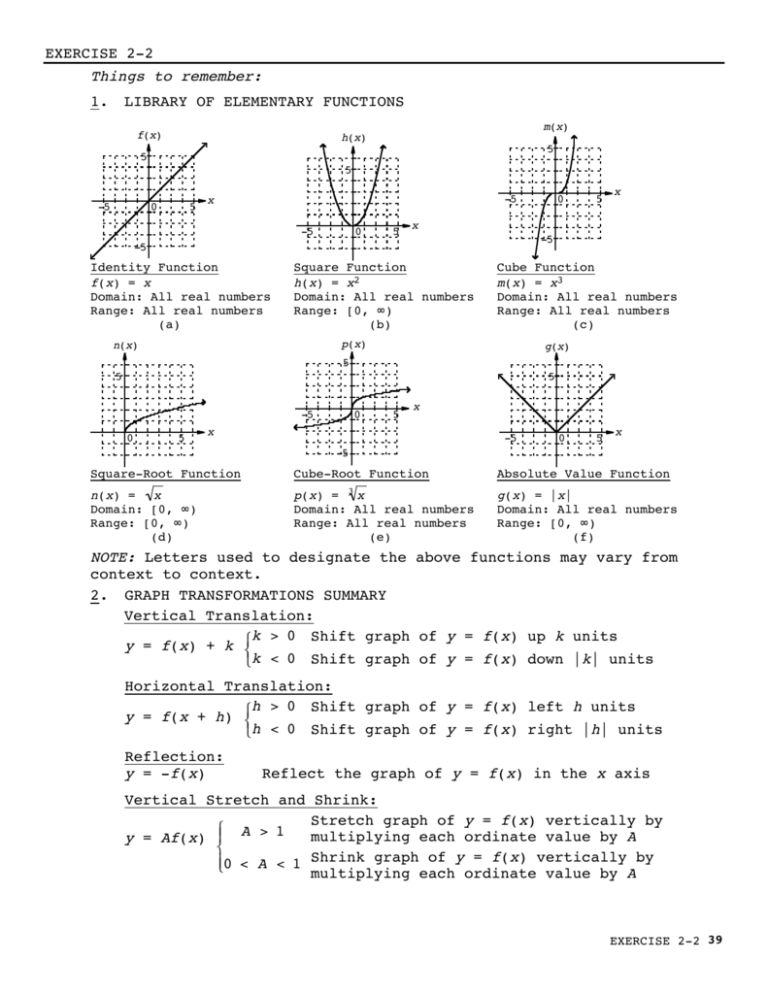
EXERCISE 2-2 Things to remember: 1. LIBRARY OF ELEMENTARY FUNCTIONS f(x) m(x) h(x) 5 5 5 -5 0 5 -5 x -5 0 5 x -5 Square Function h(x) = x2 Domain: All real numbers Range: [0, ∞) (b) Cube Function m(x) = x3 Domain: All real numbers Range: All real numbers (c) p(x) n(x) 5 x -5 Identity Function f(x) = x Domain: All real numbers Range: All real numbers (a) 0 g(x) 5 5 5 -5 0 5 0 5 x x -5 0 5 x -5 Square-Root Function n(x) = x Domain: [0, ∞) Range: [0, ∞) (d) Cube-Root Function 3 p(x) = x Domain: All real numbers Range: All real numbers (e) Absolute Value Function g(x) = |x| Domain: All real numbers Range: [0, ∞) (f) designate the above functions may vary from !NOTE: Letters used to ! context to context. 2. GRAPH TRANSFORMATIONS SUMMARY Vertical Translation: k > 0 Shift graph of y = f(x) up k units y = f(x) + k !" #k < 0 Shift graph of y = f(x) down |k| units Horizontal Translation: !h > 0 Shift graph of y = f(x) left h units y = f(x + h) " #h < 0 Shift graph of y = f(x) right |h| units Reflection: y = -f(x) Reflect the graph of y = f(x) in the x axis Vertical Stretch and Shrink: Stretch graph of y = f(x) vertically by " multiplying each ordinate value by A y = Af(x) $ A > 1 # $%0 < A < 1 Shrink graph of y = f(x) vertically by multiplying each ordinate value by A ! EXERCISE 2-2 39 3. PIECEWISE-DEFINED FUNCTIONS Functions whose definitions involve more than one rule are called PIECEWISE-DEFINED FUNCTIONS. For example, $ if x < 0 f(x) = | x | = %"x & x if x # 0 is a piecewise-defined function. To graph a piecewise-defined function, graph each rule over the appropriate portion of the domain. ! 1. f(x) = 2x; domain: all real numbers; range: all real numbers 3. h(x) = -0.6 x ; domain: [0, ∞); range: (-∞, 0] 5. m(x) = 3|x|; domain: all real numbers; range: [0, ∞) 7. r(x) = -x3; domain: all real numbers; range: all real numbers ! 9. 11. 13. 15. 17. 19. 21. The graph of g(x) = -|x + 3| is the graph of y = |x| reflected in the x axis and shifted 3 units to the left. 40 CHAPTER 2 FUNCTIONS AND GRAPHS 23. The graph of f(x) = (x - 4)2 - 3 is the graph of y = x2 shifted 4 units to the right and 3 units down. 25. The graph of f(x) = 7 - x is the graph of y = x reflected in the x axis and shifted 7 units up. ! ! 27. The graph of h(x) = -3|x| is the graph of y = |x| reflected in the x axis and vertically expanded by a factor of 3. 29. The graph of the basic function y = x2 is shifted 2 units to the left and 3 units down. Equation: y = (x + 2)2 - 3. 31. The graph of the basic function y = x2 is reflected in the x axis, shifted 3 units to the right and 2 units up. Equation: y = 2 - (x - 3)2. 33. The graph of the basic function y = x is reflected in the x axis and shifted 4 units up. Equation: y = 4 - x . 35. The graph of the basic function y = x3 is shifted 2 units to the left and 1 unit down. Equation: y =! (x + 2)3 - 1. ! 37. g(x) = x " 2 - 3 39. g(x) = -|x + 3| 41. g(x) = -(x - 2)3 - 1 ! f 5 43. x x 45. 30 47. 100 80 20 –5 5 60 x 40 10 20 –5 y 10 20 20 40 60 80 y 49. The graph of the basic function: y = |x| is reflected in the x axis and has a vertical contraction by the factor 0.5. Equation: y = -0.5|x|. EXERCISE 2-2 41 51. The graph of the basic function y = x2 is reflected in the x axis and is vertically expanded by the factor 2. Equation: y = -2x2. 53. The graph of the basic function y = 3 x is reflected in the x axis and is vertically expanded by the factor 3. Equation: y = -3 3 x . 55. Vertical shift, horizontal shift. ! Reversing the order does not change the result. Consider a point ! (a, b) in the plane. A vertical shift of k units followed by a horizontal shift of h units moves (a, b) to (a, b + k) and then to (a + h, b + k). In the reverse order, a horizontal shift of h units followed by a vertical shift of k units moves (a, b) to (a + h, b) and then to (a + h, b + k). The results are the same. 57. Vertical shift, reflection in the x axis. Reversing the order can change the result. For example, let (a, b) be a point in the plane with b > 0. A vertical shift of k units, k ≠ 0, followed by a reflection in the x axis moves (a, b) to (a, b + k) and then to (a, -[b + k]) = (a, -b - k). In the reverse order, a reflection in the x axis followed by the vertical shift of k units moves (a, b) to (a, -b) and then to (a, -b + k); (a, -b - k) ≠ (a, -b + k) when k ≠ 0. 59. Horizontal shift, reflection in y axis. Reversing the order can change the result. For example, let (a, b) be a point in the plane with a > 0. A horizontal shift of h units followed by a reflection in the y axis moves (a, b) to the point (a + h, b) and then to (-[a + h], b) = (-a - h, b). In the reverse order, a reflection in the y axis followed by the horizontal sift of h units moves (a, b) to (-a, b) and then the (-a + h, b), (-a - h, b) ≠ (-a + h, b) when h ≠ 0. 61. (A) The graph of the basic function y = x is reflected in the x axis, vertically expanded by a factor of 4, and shifted up 115 units. ! (B) 42 CHAPTER 2 FUNCTIONS AND GRAPHS 63. (A) The graph of the basic function y = x3 is vertically contracted by a factor of 0.00048 and shifted right 500 units and up 60,000 units. (B) 8.50 + 0.0650x if 65. (A) S(x) = "# $8.50 + 0.0650(700) + 0.09(x ! 700) if 8.50 + 0.0650x if 0 ! x ! 700 = "# if x > 700 $!9 + 0.09x 0 ! x ! 700 x > 700 S (B) 100 50 700 x 67. (A) If 0 ≤ x ≤ 30,000, T(x) = 0.035x, and T(30,000) = 1,050. If 30,000 < x ≤ 60,000, T(x) = 1,050 + 0.0625(x - 30,000) = 0.0625x - 825, and T(60,000) = 2,925. If x > 60,000, T(x) = 2,925 + 0.0645(x - 60,000) = 0.0645x - 945. $&0.035x if 0 " x " 30, 000 Thus, T(x) = %0.0625x # 825 if 30, 000 < x " 60, 000 &'0.0645x # 945 if x > 60, 000 T (B) (C) T(40,000) = 0.0625(40,000) - 825 = 1,675; $1,675 4,000 3,000 ! 2,000 1,000 60,000 x 69. (A) The graph of the basic function y = x is vertically expanded by a factor of 5.5 and shifted down 220 units. T(70,000) = 0.0645(70,000) - 945 = 3,570; $3,570 71. (A) The graph of the basic function y = x is vertically expanded by a factor of 7.08. function y = x is vertically expanded by ! (B) (B) EXERCISE 2-2 43

